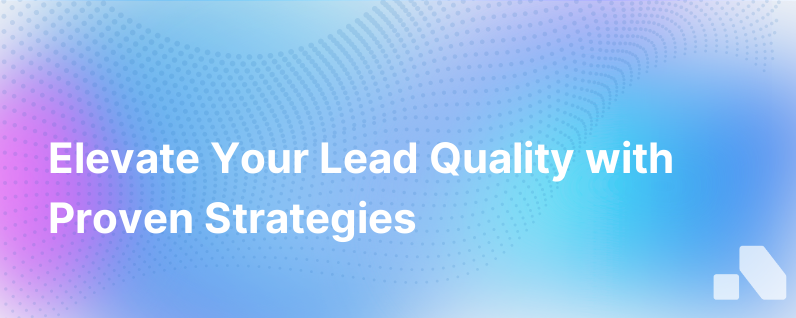Lead Quality
Published on November 15, 2023 by Sawyer Middeleer
In the realm of sales and marketing, leads are the lifeblood fueling the growth engine of any business. But not all leads are created equal. As we navigate through the choppy waters of lead generation and customer acquisition, the nuances of lead quality take center stage. Understanding, distinguishing, and improving the quality of leads is not just beneficial but essential for optimizing marketing efforts, enhancing sales productivity, and ultimately, increasing your bottom line.
In this in-depth exploration, we will demystify lead quality, illustrating the significance of this pivotal aspect and delineating actionable strategies for assessing and elevating the quality of your leads.
Understanding Lead Quality: A Multidimensional Construct
Lead quality refers to the propensity of a lead to convert into a paying customer. The ‘quality’ of a lead is measured by a combination of factors such as leads’ demographic details, how they fit your buyer persona, their engagement with your marketing content, the stage of the buying cycle they are in, and their potential lifetime value.
Let’s take a closer look at each aspect that contributes to a lead's overall quality.
Fit
The cornerstone of lead quality is 'fit'. Is the lead a good match for your product or service based on their demographics, firmographics, psychographics, and behavior? To determine fit, one must have well-defined buyer personas that encapsulate the characteristics of an ideal customer. This sets the groundwork for gauging how closely a prospect aligns with your target audience.
Interest and Engagement
A lead who has repeatedly interacted with your content or brand indicates a higher level of interest - and by extension, quality. Engagement can be measured through website visits, content downloads, webinar attendance, email opens, and social media interaction. Establishing scoring models to measure such engagement can vastly improve your ability to discern higher quality leads from the rest.
Buying Stage
Where a lead falls in the sales funnel is yet another crucial determinant of quality. Can a lead be considered marketing-qualified (MQL) or sales-qualified (SQL)? MQLs are typically leads that have shown some interest and fit the criteria but are not ready to talk to sales yet. SQLs, on the other hand, have indicated an intent to purchase and warrant direct sales follow-ups.
Lead Behavior
A potential customer's behavior provides key insights into their level of interest and the urgency of their need. For instance, a lead downloading a buyer’s guide or pricing information may be closer to making a purchasing decision than one who views a general industry trends blog post.
Potential Lifetime Value (LTV)
Projected LTV is an advanced yet essential metric for assessing lead quality. High LTV leads might initially require more nurturing and time to convert, but their potential return on investment could be far more substantial in the long run.
Assessing Lead Quality: More Than Meets the Eye
So, how does one assess the multidimensional construct of lead quality? Here are strategic steps:
1: Define Clear Lead Qualification Criteria
Develop a checklist of qualifications that leads must meet to be deemed high quality. This includes criteria from the identifiable characteristics to specific behaviors, such as minimum interaction thresholds with your marketing materials.
2: Implement Lead Scoring Models
Lead scoring is an automated methodology that assigns values to leads based on their actions and profile data. Define scoring thresholds to segregate leads into categories such as hot, warm, or cold, based on their likelihood to convert.
3: Nurture Leads Appropriately
Distinguish the pathways for nurturing different leads to foster engagement. Tailored content and communication strategies can help convert leads lower in quality over time.
4: Refine Models Through Analysis and Feedback
Continually assessing your lead quality models and adjusting them based on real data and sales feedback is key. Hold regular sessions with your sales team to discuss which leads are converting and why.
5: Employ Technology and Tools
Today, intelligent platforms like Aomni harness AI to predict and improve lead quality, streamline lead generation efforts, and offer a data-driven approach to sales strategy.
The Impact of Superior Lead Quality
Enhancing lead quality affects almost every facet of the business positively. These are just some of the benefits:
- Improved Sales Efficiency: High-quality leads reduce time wastage on unfruitful prospects, allowing your sales team to focus on leads that are more likely to convert.
- Increased Conversion Rates: Quality leads are, by definition, more likely to convert into paying customers, thus boosting your conversion rates.
- Cost-Effectiveness: Allocating resources to nurture and convert high-quality leads ensures a better ROI on marketing and sales spend.
- Customer Satisfaction and Retention: High-quality leads often translate into customers who require your solution and are more likely to be satisfied and loyal.
Conclusion: Magnifying the Magnitude of Lead Quality
Analyzing and enhancing lead quality is not about chasing a single KPI. It's a holistic approach that involves aligning your marketing content, sales tactics, and strategic goals around the needs and behaviors of your potential customers. The pursuit of lead quality transcends mere numbers; it's about fostering genuine connections that resonate with the prospects most likely to believe in your offering and invest in your brand.
In this age of data-driven decision-making, tools like Aomni can be instrumental in sorting the wheat from the chaff, directing your energies to leads that will not just add to your customer base but become advocates of your value proposition. With the right approach, patience, and smart use of technology, your lead quality can become your competitive edge in a crowded marketplace.